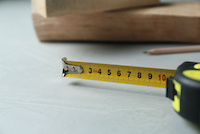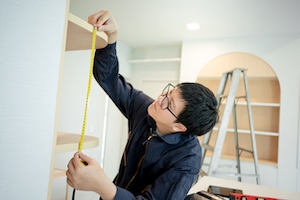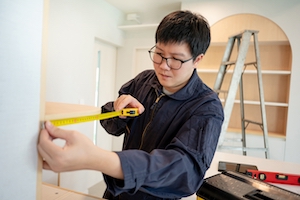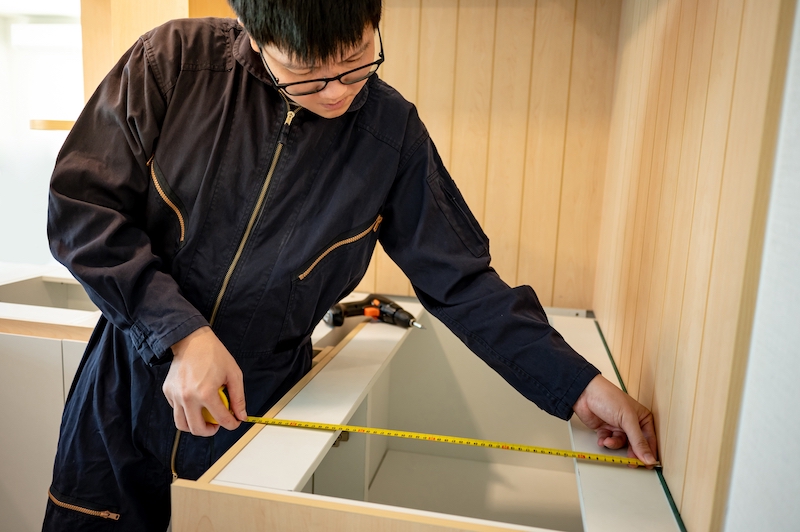How to Measure Kitchen Cabinets Like a Pro: The Ultimate Guide
by Gary Wade • September 12, 2023
Accurate measurements are crucial when it comes to installing kitchen cabinets. Whether you're giving your kitchen a makeover or constructing it anew, mastering the art of precise kitchen cabinet measurements is indispensable. This comprehensive guide will lead you through each step, empowering you to measure your kitchen cabinets with professional finesse.
Exploring Cabinet Varieties
Prior to delving into the measurement procedure, it's crucial to grasp the various cabinet types you might come across in your kitchen. The three primary categories include:
These are the cabinets that sit on the floor, providing essential storage space.
- Base Cabinets: These are the cabinets that sit on the floor, providing essential storage space.
- Wall Cabinets: Mounted on the wall above the countertops, these cabinets maximize storage while keeping the workspace clear.
- Tall Cabinets: These are the floor-to-ceiling cabinets that offer ample storage for pantry items and other kitchen essentials.
- Specialized Cabinets: Some kitchens may have specialized cabinets like pantry cabinets, lazy Susan cabinets, or corner cabinets. These type of cabinets requires specific measurements.
Necessary Tools and Materials
To measure your kitchen cabinets accurately, you'll need a few tools and materials:

- Measuring Tape: A reliable measuring tape is essential for precise measurements.
- Pencil and Paper: Keep a pencil and paper handy to jot down your measurements.
- Step Ladder: Depending on the height of your cabinets, a step ladder might be necessary for reaching the top.
- Additional Tools: Some specialized cabinets may require additional tools such as an angle finder or a contour gauge.
Setting Up Your Work Area
Before starting the measuring process, it's important to prepare your workspace:
- Clearing the Area: Remove any objects or obstacles that might hinder accurate measurements.
- Safety Measures: Prioritize creating a stable and secure workspace. Use a step ladder with care and exercise extra caution when working with sharp tools.
Taking Measurements of Base Cabinets
Measuring base cabinets involves determining the width, height, and depth of each cabinet:
- Width Measurement: Measure the width of the cabinet from left to right, ensuring you include any trim or overhang.
- Height Measurement: Measure the height of the cabinet from the floor to the top, including any countertop if applicable.
- Depth Measurement: Measure the depth of the cabinet from the front edge to the back.
Measuring Wall-Mounted Cabinets
Wall cabinets require measurements for height, space between cabinets, and width:
- Height from the Floor: Measure the height of the cabinet from the floor to the bottom of the cabinet.

- Space Between Wall Cabinets: Measure the space between two adjacent wall cabinets, if applicable.
- Width Measurement: Measure the width of the cabinet from left to right, including any trim or decorative elements.
Measuring Tall Cabinets
Tall cabinets, such as pantry cabinets, have specific height, width, and depth measurements:
- Height Measurement: Measure the height of the cabinet from the floor to the top, including any countertop if applicable.
- Width Measurement: Measure the width of the cabinet from left to right, including any trim or decorative elements.
- Depth Measurement: Measure the depth of the cabinet from the front edge to the back.
Measuring Specialized Cabinets
Specialized cabinets require additional measurements due to their unique features:
- Pantry Cabinets: Measure the height, width, and depth of the pantry cabinet, ensuring you account for any specialized shelving or drawers.
- Lazy Susan Cabinets: Measure the width and depth of the cabinet, ensuring you account for the rotation mechanism.
- Corner Cabinets: Measure the width and depth of the cabinet, taking into consideration the shape and design.
Addressing Cabinet Openings
When measuring for cabinet openings, take into account the following:

- Measuring Appliance Openings: Measure the width, height, and depth of the cabinet openings needed for appliances like ovens, microwaves, or dishwashers.
- Measuring Sink and Faucet Openings: Measure the width and depth of the cabinet openings required for sinks and faucets, ensuring sufficient clearance and functionality.
Tips for Precision in Measurements
To ensure accurate measurements, follow these tips:
- Measuring Twice, Cutting Once: Double-check your measurements before making any cuts or purchasing cabinets.
- Dealing with Irregular Spaces: If your kitchen has uneven walls or floors, make sure to measure at multiple points and account for any variations.
- Common Pitfalls to Avoid: Be mindful of potential obstacles such as light switches, outlets, or plumbing fixtures that might affect the cabinet placement or measurements.
Recording Measurements

Maintaining comprehensive records and sketches is crucial throughout the measurement procedure:
- Sketching the Layout: Create a rough sketch of your kitchen layout, noting the measurements and placement of each cabinet.
- Keeping Detailed Notes: Write down all your measurements, including heights and widths, as well as any other relevant details. This practice will assist you in maintaining orderliness and guaranteeing precision during the installation phase.
Verifying Your Measurements
Once you have finished measuring all your cabinets, it's crucial to double-check your measurements before proceeding:
- The Importance of Accuracy: Precision is key when it comes to installing kitchen cabinets. By cross-referencing your measurements, you can prevent expensive errors and guarantee a perfect fit.
- Verifying Critical Dimensions: Pay close attention to critical dimensions such as the height and width of cabinets that need to align with appliances or countertops. Ensure the precision of these measurements to prevent any complications during the installation process.
Accurate measurements are the foundation for successful kitchen cabinet installation. By following this ultimate guide and understanding the importance of precision, you can measure your kitchen cabinets like a pro. Remember to dedicate ample time, verify your measurements, and diligently document every detail to ensure a seamless and trouble-free installation journey.
Frequently Asked Questions
How often should I update my cabinet measurements?
It's recommended to update your cabinet measurements whenever significant changes occur in your kitchen layout, such as remodeling or replacing appliances.
Can I use digital tools for measuring?
Yes, digital tools such as laser measuring devices or smartphone apps can be helpful for precise measurements. Just ensure their accuracy and use them in conjunction with traditional measuring methods.
What if my kitchen has uneven walls or floors?
If your kitchen has uneven walls or floors, take multiple measurements at different points and use the average to ensure accurate cabinet measurements. Adjustments can also be made during installation to accommodate irregularities.
How can I ensure an exact fit for my kitchen cabinets?
Besides accurate measuring, it's important to consider factors like clearance requirements, functionality, and aesthetic preferences. Consult with professionals or refer to manufacturer guidelines for specific cabinet fitting recommendations.
Following this guide and utilizing the right tools and techniques will allow you to accurately gauge the dimensions of your kitchen cabinets. This approach will contribute to a kitchen space that is not only practical but also visually appealing.


